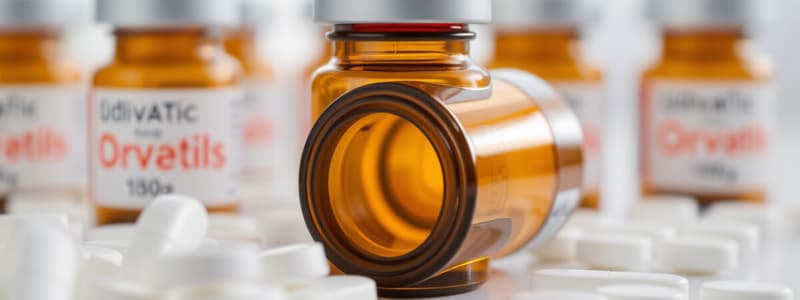Podcast
Questions and Answers
What is the drug class that dilates the pupil?
What is the drug class that dilates the pupil?
- Cycloplegics
- Miotics
- Sympathomimetics
- Mydriatics (correct)
What is the drug class that constricts the pupil?
What is the drug class that constricts the pupil?
miotics
How long should you wait between giving 2 different eyedrops?
How long should you wait between giving 2 different eyedrops?
15 minutes
How long should you wait between giving multiple drops of the same eyedrop?
How long should you wait between giving multiple drops of the same eyedrop?
What is the drug class that paralyzes the ciliary body?
What is the drug class that paralyzes the ciliary body?
What are the potential side effects of administering indirect-acting and direct-acting cholinergics?
What are the potential side effects of administering indirect-acting and direct-acting cholinergics?
What drug class mimics sympathetic neurotransmitters and causes eye dilation?
What drug class mimics sympathetic neurotransmitters and causes eye dilation?
What is a systemic effect of beta-adrenergic blockers?
What is a systemic effect of beta-adrenergic blockers?
The ocular drug class that reduces intraocular pressure and may cause nausea and ____________ is called carbonic anhydrase inhibitors.
The ocular drug class that reduces intraocular pressure and may cause nausea and ____________ is called carbonic anhydrase inhibitors.
Osmotic diuretics like glycerin and mannitol are indicated before & after ocular __________ to reduce IOP.
Osmotic diuretics like glycerin and mannitol are indicated before & after ocular __________ to reduce IOP.
What is the newest class of drugs for glaucoma?
What is the newest class of drugs for glaucoma?
What is the certain macrolide used to prevent gonorrhea eye infections in newborns?
What is the certain macrolide used to prevent gonorrhea eye infections in newborns?
What should be applied pressure to, to reduce systemic absorption of the drug?
What should be applied pressure to, to reduce systemic absorption of the drug?
Which anti-inflammatory agents are used prophylactically after ocular surgery?
Which anti-inflammatory agents are used prophylactically after ocular surgery?
What do artificial tears provide for dry or irritated eyes?
What do artificial tears provide for dry or irritated eyes?
What is the immunosuppressant drug used to treat dry eyes?
What is the immunosuppressant drug used to treat dry eyes?
What adverse effects can result from the use of ophthalmic anesthetics?
What adverse effects can result from the use of ophthalmic anesthetics?
What should be monitored for with the use of corticosteroids in conjunction with ophthalmic antibiotics?
What should be monitored for with the use of corticosteroids in conjunction with ophthalmic antibiotics?
Flashcards are hidden until you start studying
Study Notes
Mydriatics and Miotics
- Mydriatics: drugs that dilate the pupil.
- Miotics: drugs that constrict the pupil.
Eyedrop Administration
- Wait 15 minutes between different eyedrops.
- Wait 5 minutes between multiple doses of the same eyedrop.
Cycloplegics
- Cycloplegics: drug class that paralyzes the ciliary body.
Cholinergic Drugs
- Indirect-acting and direct-acting cholinergics reduce intraocular pressure (IOP).
- Possible adverse effects: hypotension, bradycardia, tachycardia, headache, stomach problems, asthma attacks.
Sympathomimetics
- Sympathomimetics mimic epinephrine & norepinephrine, cause eye dilation, and reduce IOP.
- Local adverse effects: burning, pain, lacrimation.
- Rare sympathetic effects: hypertension, extrasystoles, headache, faintness.
Beta-Adrenergic Blockers
- Reduce IOP; may cause transient burning, discomfort, blurred vision, pain, and photophobia.
- Systemic effects: dizziness, headache, cardiac irregularities, bronchospasm.
Carbonic Anhydrase Inhibitors
- Reduce IOP but are used less frequently due to adverse effects.
- Oral adverse effects include drowsiness, confusion, transient myopia, tinnitus, anorexia, vomiting, diarrhea.
Osmotic Diuretics
- First-line: glycerin; Second: mannitol; Third: isosorbide.
- Used before & after ocular surgery to reduce IOP.
- Possible gastrointestinal issues and fluid or electrolyte imbalances.
Prostaglandin Agonists
- Newest class of drugs for glaucoma; example: latanoprost (Xalatan).
- Reduces IOP and may permanently change eye color to brown.
Erythromycin
- Macrolide antibiotic used to prevent gonorrhea eye infections in newborns and treat chlamydia-induced conjunctivitis.
Trifluridine
- Used for ocular infections caused by herpes simplex virus types 1 & 2.
- Adverse effects: secondary glaucoma, corneal punctate defects, uveitis, stromal edema.
Antifungal Treatments
- Natamycin (Natacyn): anti-fungal used topically for blepharitis, conjunctivitis, and keratitis.
Antibiotic Use with Corticosteroids
- Combining ophthalmic antibiotics with corticosteroids may complicate infection resolution.
Ocular Anti-Inflammatories
- NSAIDs and corticosteroids used prophylactically after surgery to prevent inflammation and scarring.
Ophthalmic Anesthetics
- Used only in-office settings and not for self-administration.
Atropine Sulfate
- Cycloplegic mydriatic used in ophthalmic examinations for dilation.
Diagnostic Dye
- Ophthalmic dye (fluorescein) identifies corneal defects and locates foreign objects; also used for fitting hard contact lenses.
Artificial Tears
- Provide lubrication or moisture for dry or irritated eyes.
Restasis
- Immunosuppressant drug used to treat dry eyes.
Systemic Absorption Reduction
- Apply pressure to the inner canthus for at least 1 minute to minimize systemic absorption of ophthalmic drugs.
Studying That Suits You
Use AI to generate personalized quizzes and flashcards to suit your learning preferences.



